In this video I show a couple cuneiform tablets that I made for Inanna, and then I show how I make my tablets. I also talk a little bit about the Sumerian language and my relationship with Inanna.
Tag: Sumerian
Geshtinanna: The Grapevine of Heaven
For this month’s ritual for the Rod and Ring initiatory journey, I met with the goddess Geshtinanna. I was already somewhat familiar with her and have recently incorporated her into my regular practice, so it was a somewhat different experience from the previous months were I met deities with whom I was less familiar.
Since Geshtinanna’s energy was already a bit familiar to me, it felt sort of like meeting up with an existing friend, whereas previous month’s rituals had me meeting new deities for practically the first time. Geshtinanna, or Amageshtin as I prefer to call her in ritual, has a very motherly nurturing type of energy that is instantly recognizable after working with her for the last couple of months or so.

I made Her a painting, which I based a little bit on the 9 of Pentacles tarot card. That card always reminds me of Her when it comes up, particularly in the Ethereal Visions deck (I have the Luna edition, though I think that card is the same in both versions).
I anticipate that next month’s ritual with Dumuzi will feel similar, as I am even more familiar with Him than I was with Geshtinanna. I’ve also started reading Samuel David’s newest book The Red Shepherd in preparation for my ritual meeting with Dumuzi.
I’ve also started the series of rituals for the Seven Who Decree Fate from the book Evil Speech Stand Aside by Vanessa Kindell, in which the book instructs the ritualist to perform on the night of the full moon for seven months. For this first month, I connected with Nanna, whom I have already been working with every month the night before performing the main Rod and Ring rituals. At least thus far, I’ve found that I don’t connect with the rituals from this book as deeply as I do with the ones from Rod and Ring. I’m not quite sure what the problem is, but I’m going to keep working at it. If nothing else, it will help me to become more familiar with the Seven Who Decree.
My Introduction to Geshtinanna
I’ve been exploring the worship of several other deities in the Sumerian pantheon lately, in addition to Inanna. Early this year, I started my journey through Samuel David’s Rod and Ring in an effort to become better acquainted with some of the other deities in the Mesopotamian pantheon. The main motivation being that, by becoming acquainted with and better understanding some of the other deities in Inanna’s circle and in the wider Mesopotamian pantheon, and better understanding the original religious context that she was worshiped under, I can build a deeper relationship with Her. I already have a place for Dumuzi, Inanna’s consort, and Ninshubur, Inanna’s sukkal (advisor) in my personal practice. I had been feeling drawn to Geshtinanna, Dumuzi’s older sister and Inanna’s sister-in-law, but I didn’t really where to start with her. Most of the information I find on her only mentions her in passing in her role in Dumuzi’s descent. Technically, I will be working with Geshtinanna as part of my journey through Rod and Ring next month, but it turns out she decided to show up a bit early.
As “coincidence” would have it, this month in one of the ANE polytheist groups I recently joined, the service was all about Geshtinanna! The autumn equinox had recently passed, making this the time of year when Geshtinanna returns to the underworld to take Dumuzi’s place.
One of the things I learned about her that stood out the most was that, of all the deities, Geshtinanna was the only goddess who was regularly depicted with close female friends other than those directly related to her. As such, she can be revered as an embodiment of sisterhood between women and supportive female friendships.
Geshtinanna was also considered a sort of mother-figure as well. As Dumuzi’s older sister, Geshtinanna filled a mother role for Dumuzi. She was regarded as a caring and loving sister to Dumuzi.
These aspects of caring female friendships and nurturing family support are energies that I desperately need to bring into my life, not going to lie. I feel like, since I’ve invited Her into my practice, I am slowly starting to better understand/experience these things. Do those count as Mes? I’m not really sure, but I feel like that’s the best word to describe such things. It’s obviously a slow process. She can help guide me in the right direction, but I know she isn’t just going to do the work for me. Despite what a lot of pagans seem to think (based on questions I see posted to social media all the time and spell instructions urging practitioners to invoke random deities they may or may not actually worship), you can’t (or at least shouldn’t!) try to invoke deities you have no existing relationship with just to “make” them do some task/help you with something just because it’s related to one of their associated domains. That’s just rude. That would be like if some random stranger just knocked on my door and asked me to babysit their kids just because they heard I work in childcare as my day job. No going to happen, and please get off my lawn! But that’s a whole rant for a separate post.
Geshtinanna is associated with grapes, grapevines, and wine and her name is often translated as “the grapevine of heaven.” She is also known as Amageshtin or Mutinanna (in the Emesal dialect). In my own UPG she seems to prefer to be called Amageshtin (“Ama” meaning mother). I find she has a very caring and motherly type of energy about her (in the few weeks I’ve been actively working with her).
I made for her a little statue to include her on my little shrine that also has space for Inanna, Ninshubur, and Dumuzi. I made it from wild grapevines that I harvested in the rain during the last new moon, which was also the day of a solar eclipse. I made some wreaths with my harvest as well. While my other statues were made from clay, I thought it was appropriate to make Geshtinanna’s from grapevines. This figurine is a bit fragile, so eventually it may have to be remade or perhaps reinforced with clay, but I like how it turned out. It could always be re-crafted once I improve my vine-weaving skills.
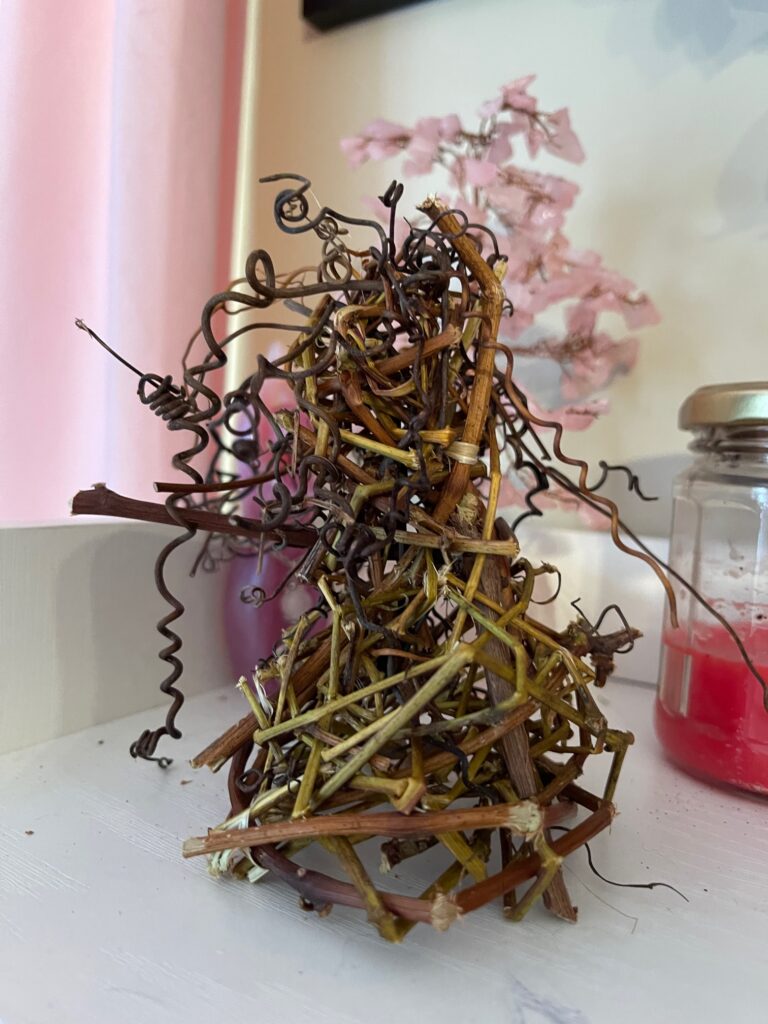
I don’t have Her whole shrine spot ready yet, but Her statue lives alongside Inanna, Ninshubur, and Dumuzi.
Since Amageshtin is so intimately entwined with the grapevine, I was a bit hesitant to start working with her in the beginning. Wine isn’t really my thing, and isn’t something I naturally connect with, and I typically avoid alcohol in general now since the whole breast cancer thing. (I typically use hibiscus tea as a substitute for wine in rituals that call for wine – it has that same deep red color and its energy is just lovely. In my experience, Ninshubur in particular enjoys hibiscus – obvious UPG alert!). But wine can still be offered to deities even if you don’t personally imbibe, and she seems to enjoy regular grape juice just as much. I’ve been using grape juice as offerings more than wine. Since I don’t personally care for wine, offering it always feels like “here, I didn’t want this, so I guess you can have it,” whereas grape juice feels more like “this is good, so I wanted you to have some too!”
I’ve also been working with Ningal a bit too. I did her ritual from Rod and Ring this month (technically I had my first experience with her during the full moon last month while doing some light trance work as well. I’m not sure if it was “real” or whatever, but I’m trying to learn to trust my intuition in these types of things) and felt a connection there, and a feeling that I should be involving her in my regular practice in some way. I’m still exploring what this means, which I suppose is technically a lifelong process (anyone who tells you they have all spiritual things figured out is either delusional or trying to sell you something or both). I’ll make a separate post about Her soon once I’ve gathered my thoughts a bit more and finish the painting I’m making for Her in Adobe Fresco so I can include it in the post. I want to make her a statue too and set up a shrine, but I’m still thinking about what the statue should look like, and whether or not she should share the same space as Inanna, Ninshubur, Gestinanna, and Dumuzi or have her own space.
Inanna and the Huluppu Tree – Children’s Book Progress
I’ve been working on a new children’s picture book based on the Mesopotamian myth of the Huluppu Tree. I’m hoping to have it ready to release next month, by Thanksgiving (and the holiday shopping season!)
I wrote first draft of the text last month. I based it mostly on the popular translation by Samuel Noah Kramer, but simplified for the children’s picture book format. I did change “Lilith” to an owl, as respectable Assyriologists now agree that the Sumerian term ki-sikil-lil-la-ke from the original Sumerian version of the myth isn’t related to the Semitic folklore figure Lilith. One theory is that this inhabitant of the tree was simply meant to be an owl. It may have also been meant to represent a spirit or demon of some sort. For the purpose of a children’s book, I think that an owl is the best translation to get the point across. Owls are mysterious creatures of the night, while still being something that a child raised in the modern world can understand (without having nightmares).
In addition to the draft of the story adaptation itself, have also completed the story board and started working on the illustrations. I’m about a third of the way through drawing the illustrations right now. In the illustrations, I have interpreted the Huluppu tree as a willow-like tree. There are other interpretations of what kind of tree the Huluppu tree could have been, but willow seems to be the most common interpretation. I’ve also seen it proposed as a date palm. Aside from the willow interpretation being more popular, I think the symbolism and magickal properties of the willow tree work a little bit better than the date palm. Willows feel like they have a more feminine type of energy than the date palm to me, and they can symbolize rebirth, healing, and rapid growth. (The date palm would also have been a good choice symbolically, as they can represent fertility and abundance, though I feel like the willow is slightly more fitting for the purpose of this book).
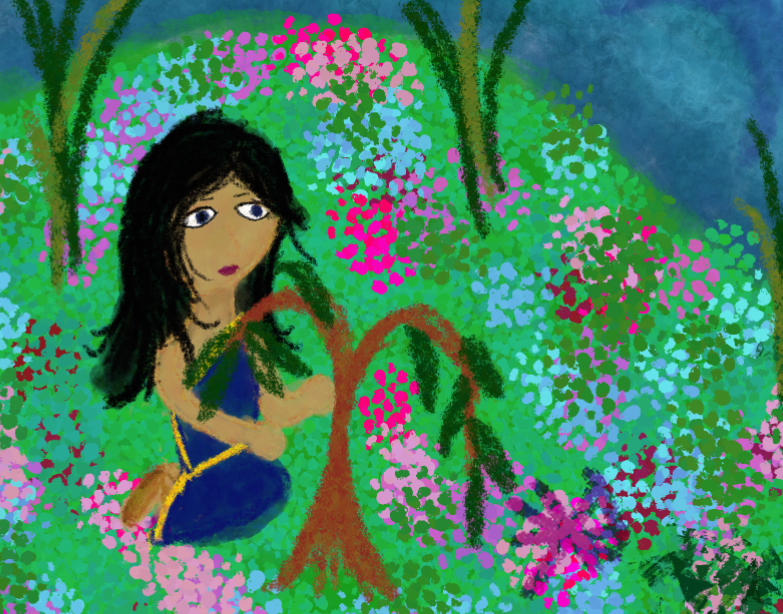
I still need to finish the illustrations, write the text for the front and back matter (glossary, brief historical overview, about the author, etc), and revise and edit the text and illustrations.
If this project goes well and there is any interest, I may eventually make a whole series of children’s books based on Sumerian myths. I will likely focus mainly on myths involving goddesses, especially Inanna.
I got the idea to write children’s books based on Mesopotamian mythology from the one existing picture book I found based on Inanna’s Descent. That one got the story completely wrong and changed so many details that it was completely unrecognizable aside from the characters’ names. I’d like to write my own children’s book version of the Descent myth and the myth where Inanna receives the mes from Enki. The challenge will be adapting them to be appropriate for modern-day children while still remaining accurate to the original myths.
I also have an idea for an novel (or more likely, novella – right now I’m estimating about 30,000-40,000ish words, though that could always change drastically as I add and/or remove ideas – I’m still in the very early stages of planning) based on the myths involving Inanna as well. I’m working on researching and outlining it now, and I’m planning to start writing it next month during NaNoWriMo. While I plan to write during NaNoWriMo, I think I’m going to do the challenge in a non-traditional way this year. I’m planning on writing the first draft for this short novel, and also finish up the children’s book during November, but not get caught up on word counts. I want this book to be more of a lyrical, succinct style, reminiscent of books like Hermann Hesse’s Siddhartha and the like. Something that has spiritual value, and that feels more like a classic rather than just another run-of-the-mill fantasy based loosely on mythology.
Whenever I do NaNoWriMo, I tend to get too caught up on quantity of words, rather than quality. This means I end up with a manuscript filled with useless nonsense that I never feel like wading through to salvage a story that I actually want to share with anyone. I like NaNoWriMo for the fact that it pushes me to write even when I don’t feel like I have the time, but I also recognize that it does encourage the bad habit of writing in a way that focuses on higher word counts over quality story telling.
Nisaba and the Invention of Writing, and Nanna and the New Moon (paintings)

I made this painting for Nisaba, the Sumerian Goddess associated with writing, and also grain, after performing her rituals for Rod and Ring this month. I want to do something extra to honor each deity as I complete their rituals. I call is Dub Sar: Nisaba and the Invention of Writing. She was originally associated with grain, but became associated with writing after its invention due to the use of reeds as styluses. I used the most famous carved image of Nisaba as the inspiration, but switched the grain stalks she held for her lapis tablet and golden stylus to emphasis her importance as a patron goddess of scribes, know as dub sar in Sumerian.
I was originally writing articles for HubPage’s network site Exemplore (where they route all pagan-related topics, along with other, but decided to switch to paintings. I still need to go back and complete my paintings for Gibil, Ninurta, and Ishkur. I’ve realized that HubPages isn’t the best place to try to elevate the gods since they lump all things pagan in with garbage like conspiracy theories, UFOs and Aliens, New Age, etc.

I also did a painting for Nanna this month during the dark moon. I call it Udnua, which means New Moon in Sumerian. This one features Nanna seated before the dark moon. I made the initial sketch by tracing one of my favorite stone images of him. I tried to emphasize the shining gold details of the Shining One and his divine magical accoutrements.
Both of these art peices are available as prints from my various art sales channels. I particularly recommend these mini prints that come with wooded bases, available on my Threadless Artist Shop. These are perfect to use as images of the deities for your altar or shrine!
So far I have Inanna, Marduk, Nanna, and Nisaba. I’m working on making one for Dumuzi, and will soon start painting Gibil, Ninurta, and Ishkur. Next month I will start working on one for Ningal, and then Gestinanna after I complete their rituals for Rod and Ring. I’m already working on one for Dumuzi, but I might make another one once I complete his ritual.
My Daily Practice and Current Altar
Today I thought I’d share what my daily devotional practice to Inanna looks like, and how my altar is currently arranged. I just switched the table I use for my altar to a slightly taller one with slightly more surface space a couple days ago.
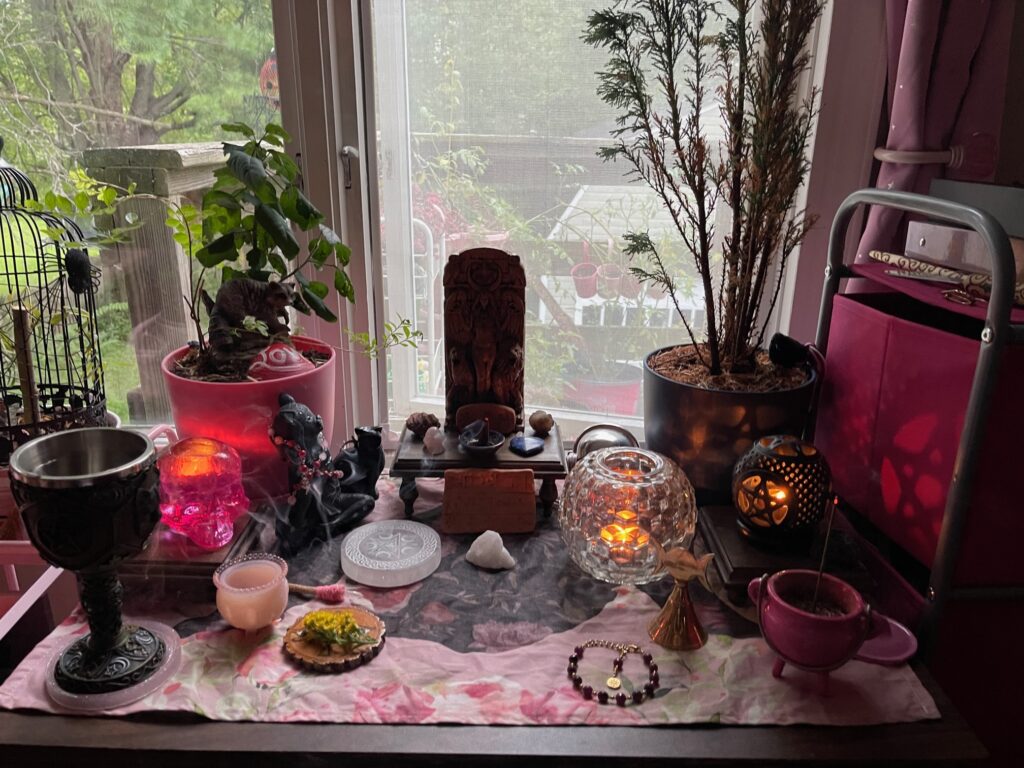
This is what my altar currently looks like. On a riser in the center is a statue of the goddess Inanna. In the riser in front of her is a small offering bowl where I burn incense. She is surrounded by a few small stones which are symbolic offerings to Her. I eventually want to make a new riser to look like a whole ass ziggurat to put Inanna’s image on, but I don’t know what materials to use to make such a thing yet. I want the statue to sit a bit higher up compared to the plants, but I still want plants on there, and they need to be in large enough pots to account for their roots.
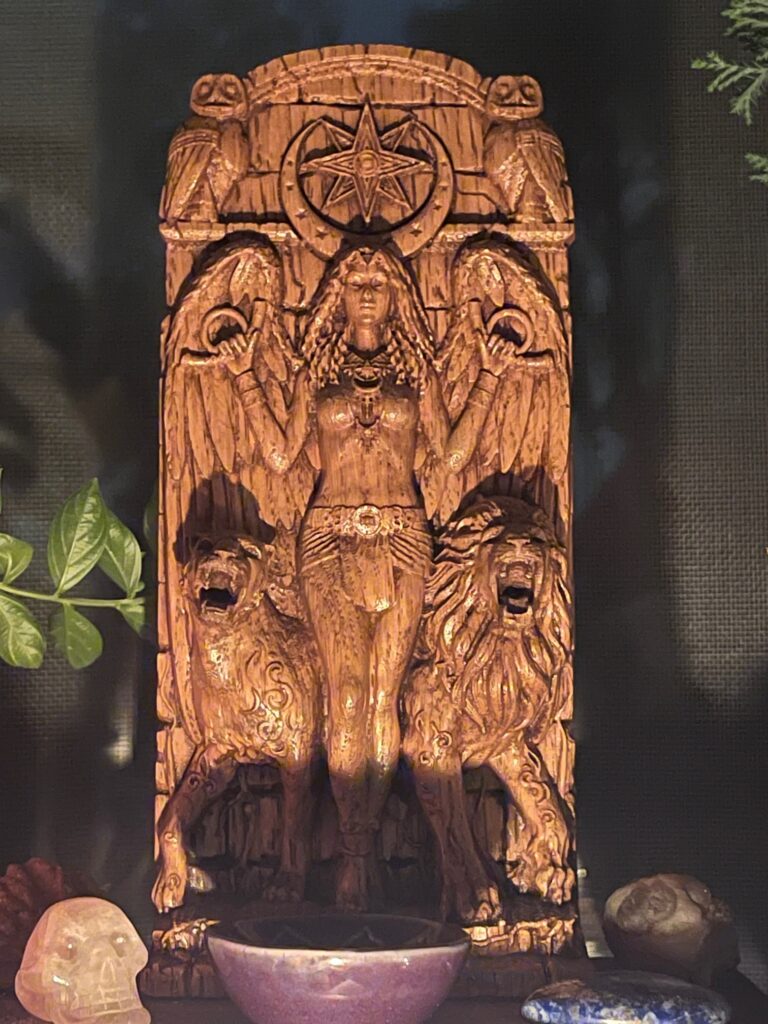
On either side of Inanna I have two potted plants. The pink pot to the left contains a crepe myrtle and a hibiscus. There’s no specific symbolic reason for these particular plants. I wanted something that flowers to represent a “spring/beginnings” and feminine sort of energy, and I had plenty of seedlings of these outside (Crepe myrtles from my Arbor Day society membership and hibiscus just pop up everywhere in my yard and garden). The cypress to the left was a gift. I feel it represents more of a masculine energy, as well as fall/winter as an evergreen. It’s not doing too well indoors, so this one will probably be planted outside around November and replaced with something else. I’m thinking a spider plant or something else that does well indoors and is safe for cats. The other two from the pink pot will eventually go outside too.
I have three candles. The center one represent Inanna. I light this one first during my daily devotionals and rituals. I use a large circular clear multifaceted candle holder, which I feel nicely represents the pure yet multifaceted energy of Inanna. Using a utility candle, I light the left one that is in the pink skull candle holder from the center candle’s flame. I think of that one as representing myself, and Inanna’s light shining through me. The third candle holder is where I put candle used in spells or specific rituals if I have one I’m doing that day. Otherwise I light it at the beginning as representing sharing my light with the world at large. I use tea light candles typically, as they burn out quicker if I forget to put them out when I’m done. I’m currently using Hanukah candle as my utility candle because I found some that share a portion of the profits with Sharsheret, an organization that helps women with hereditary breast cancer from the BRCA1/2 mutations that are commonly found in women with Jewish heritage. It feels like a nice way to honor my ancestors too, even if I don’t worship the same deity they did in recent generations.
I light incense offerings from the left candle that sort of represents myself to represent giving of myself to Inanna or any other deities I’m giving offerings to at that time.
After the candles and incense are lit, I do a short prayer/meditation using the wrist prayer beads I keep on my altar. I got the prayer beads from etsy seller HearthfireHandworks and I use the prayer that she included with the beads, with slight modifications, though one of these days I’ll probably rewrite the entire thing to better reflect my personal relationship with Inanna.
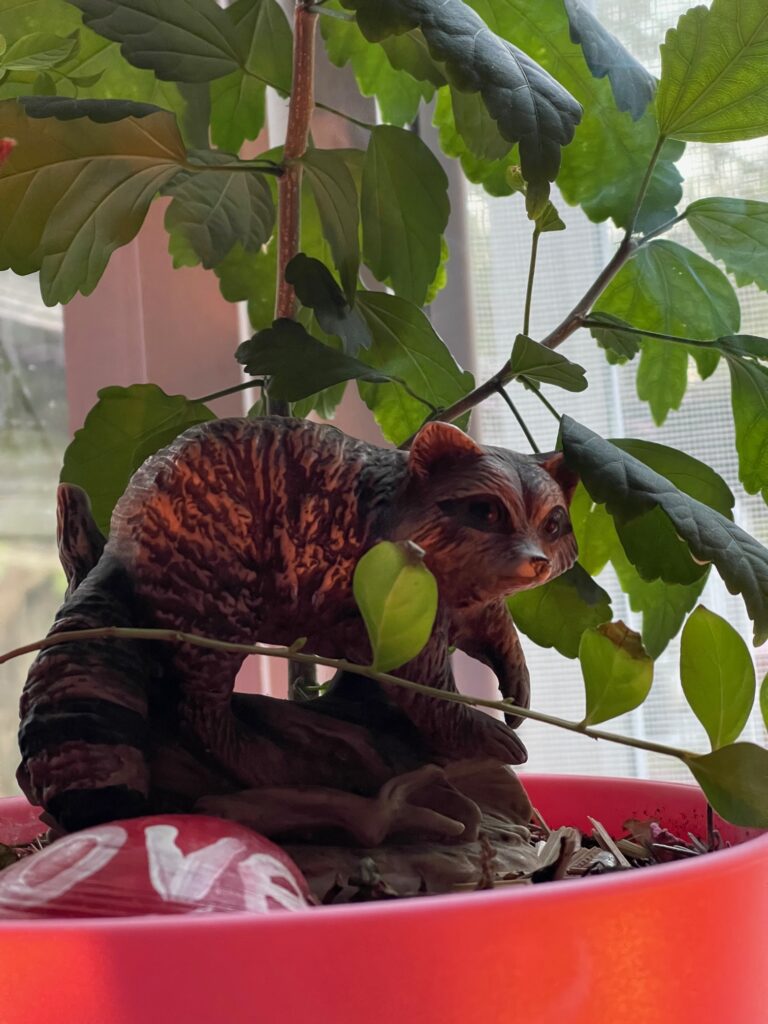
All of the classical elements are represented throughout my altar, but they are more “concentrated” in certain designated spots. On the left side of the altar, I have the tools related to the feminine elements of water and earth. I have a container for holy water and a sprinkler tool (made from a miswick stick, rope, and a quartz crystal) for water and earth. I also have a coaster to designate the spot for my chalice, a selenite pentacle altar tile (for charging and cleansing small items), a wood altar tile with an ankh symbol (where I set spell components until I need them. There is goldenrod freshly harvested from my pollinator garden on it in the picture.) The cup is in the way in the picture, but I also have a trilobite on the riser next to the skull candle holder for water and earth, also to represent the past (Earth’s past, obviously, and mine. I got it from the Seneca Cavern’s gift shop as a child). There is a painted shell that says “love” on top of the soil of the left potted plant. I found it while cleaning up trash in the Metroparks. I meant to re-hide it, but it found it’s home on my altar for now. I also have an peat turf sculpture of a cat from Ireland, which I feel gives my Irish ancestors representation, again, even if I haven’t been called by their particular deities.
On the right side, of course, I have greater concentrations of the air and fire elements, commonly considered more masculine in energy. The cauldron I use as an incense holder brings back a bit of feminine energy to the air/fire of the incense being burned. I have my little bell that I got from the Buckland Witchcraft Museum gift shop (I really like museum gift shops, if you haven’t noticed), which also represents air. Its not really visible, but there’s a lava rock I illegally brought back from the beach of Hawaii’s Big Island for fire (and also earth!). The skull-shaped speaker I use to play ritual music through is kinda hidden behind the big candle holder. I usually keep it on the floor, but I had extra space when I rearranged everything. I might swap it out for a garden gnome though, and put the speaker back on the ground. I guess I don’t really have the masculine elements represented as much as the feminine ones, but I’m also completely okay with it. This is my personal practice. I do what I want!
For music, lately I’ve been using the album “Inanna” by Neurotree. I don’t know anything about the artist, I just found it on Amazon while looking for books about Inanna (I bought the album from iTunes though). I found literally nothing about the artist other than that one album when I tried to look them up. It seems kinda sus, since usually there would be at least some info about the actual humans behind the music somewhere on the interwebs, but whatever. I like it.
In the center, right in front of the riser for Inanna’s image, I have a big chunk of quartz. I got it at some witchy/Halloween event last year in Lakewood in a scoop of “witch confetti.” The lady I bought it from picked it out of her mixture of odds and ends special for me, which was so nice! It reminds me of a mountain top, so I like to keep in down in front of Inanna, like she’s rising up above the underworld. (“Kur” can mean both “underworld” or “mountain” in Sumerian. It can also refer to foreign/eastern lands).
The tablet behind the quartz translates to “The strength of my god completes my own. Inanna is praised!” Idr if I posted the tablet as a blog post yet.
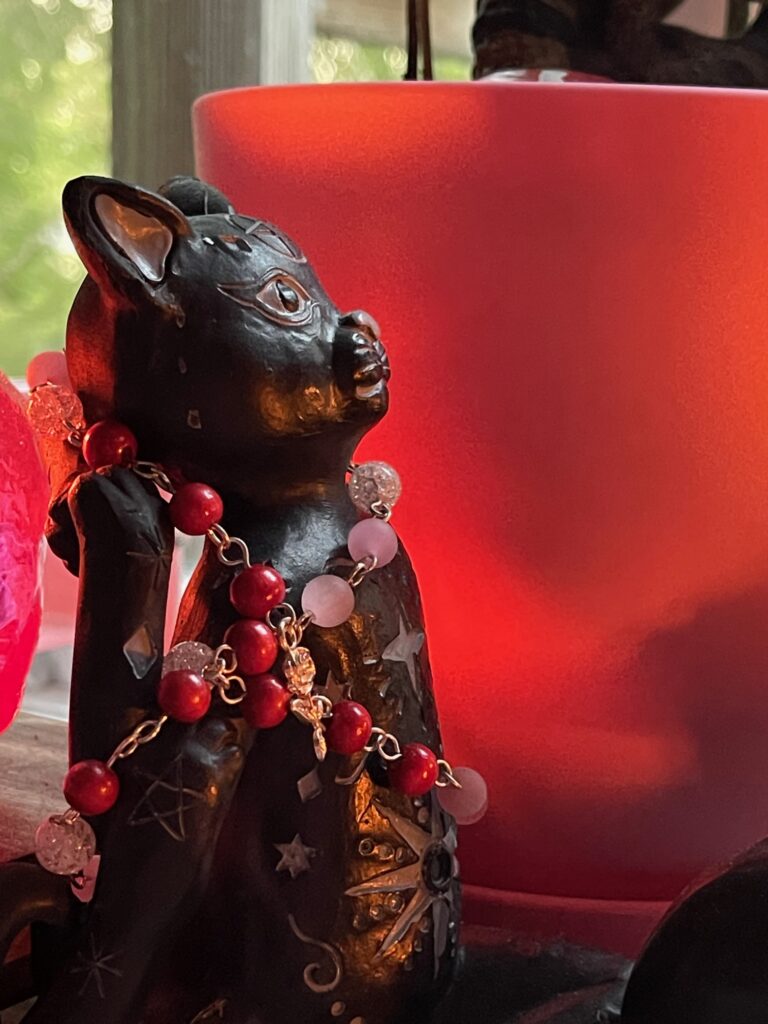
The yoga cat statue is kind of like a stand-in worshipper sort of thing. I read something before that back in the day figurines of worshipers would be left at the shrines of deities to continue “worshiping” the deity in the person’s absence. Idk how true that interpretation of the artifacts is, but I liked the idea, so I’m using the yoga cat statue in that way. It even has an 8-point star on its tummy!
This is all my own personal practice and what is meaningful to me. If I were ever called upon to put together something for the community at large for whatever reason, it would obviously stick more to traditional kinds of imagery and associations (i.e. less just making things up as I go along).
Adobe Fresco Goddess Paintings
I’ve been wanting to get back into drawing, and finally decided to splurge and get a drawing tablet (well, I did get a pretty good deal on it. It must have been a Labor Day sale, though I didn’t even think about holiday sales when I was shopping for it). I got the XP Pen Artist 16 and I’ve been experimenting with digital painting, mainly in Adobe Fresco, but also Photoshop and Illustrator. Here are two of my favorite paintings I did so far:
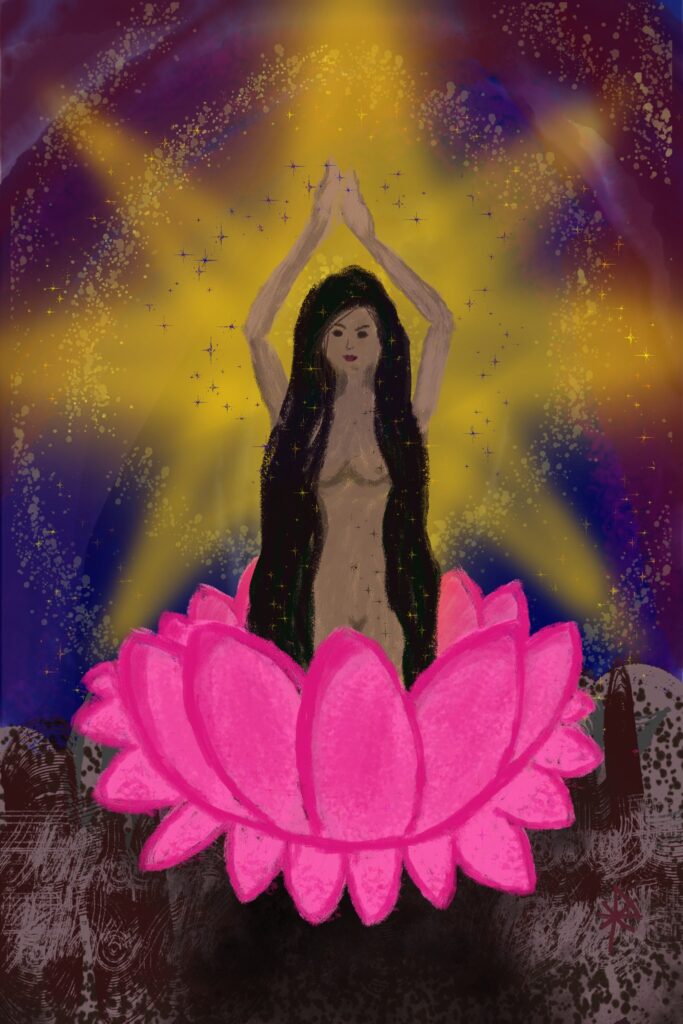
Inanna Rising was inspired by Inanna’s descent to – and subsequent ascent from – the underworld.
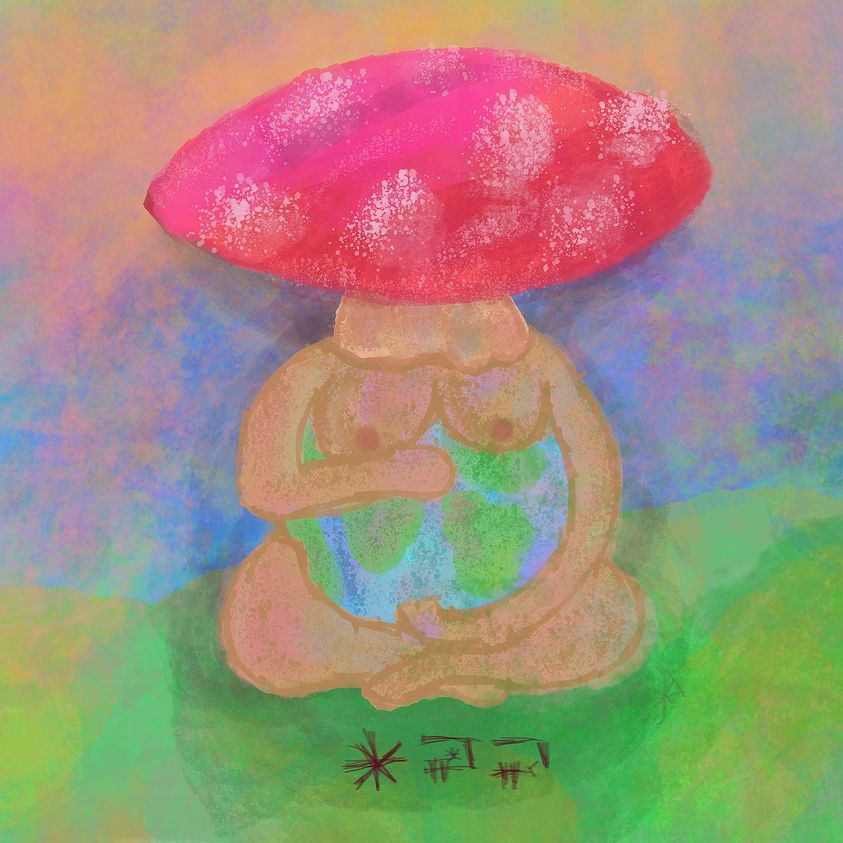
Ama Nita is a pun on the Amanita muscaria mushroom and the Sumerian word “ama” meaning “mother” (“nita” is also a word in Sumerian meaning “male,” so I supposed Ama Nita could be thought of as a fusion of the sacred feminine and masculine properties, or as a “mother of men” – interpret it as you wish!). Mushrooms have been considered sacred in numerous cultures throughout history, so an Amanita mushroom as a mother goddess seems fitting to me. I’m not sure if the Sumerians or any other Mesopotamian culture had any sacred associations with mushrooms or any other entheogens. I don’t recall reading anything (from legit sources) about such things, but who knows?
I think I’m going to have prints made of these. Would it be too narcissistic to hang my art up alongside the art I bought from “real” artists? Idk. I might offer prints once I get my etsy shop up and running too. I might not be the greatest artist of all time, but I like my digital paintings enough to want to display them, so maybe someone else out there might too.
I don’t really have much to compare the XP Pen tablet to, but I’m really enjoying using it so far. Because of the large screen and matte finish (and matte screen protector I put on it) it is a lot nicer to draw on than my iPad mini or Surface tablet (1st gen I think?). I also like it much more than Hans’s old Wacom tablet (an entry-level non-screen one), which I never got the hang of.
Anyway, I’ve been throwing around a new idea for a children’s book for a while, and now that I have a nice drawing tablet, I think I can actually execute it, so stay tuned for whenever I actually make some progress with that. I have so many different projects I want to bring to life.
Til Zu-Bir Ki-Aĝ (Live Laugh Love) Cuneiform Tablet
I translated the phrase “Live Laugh Love” into cuneiform to make a tablet to hang on the wall. I realized that, for someone who loves pumpkin spice lattes and is just generally a “basic white girl,” I didn’t have any of the the type of artwork that is generally associated with “basic bitches” hanging up in my house. You know the type, random words just displayed on the wall for no reason. So I remedied that with my own spin.
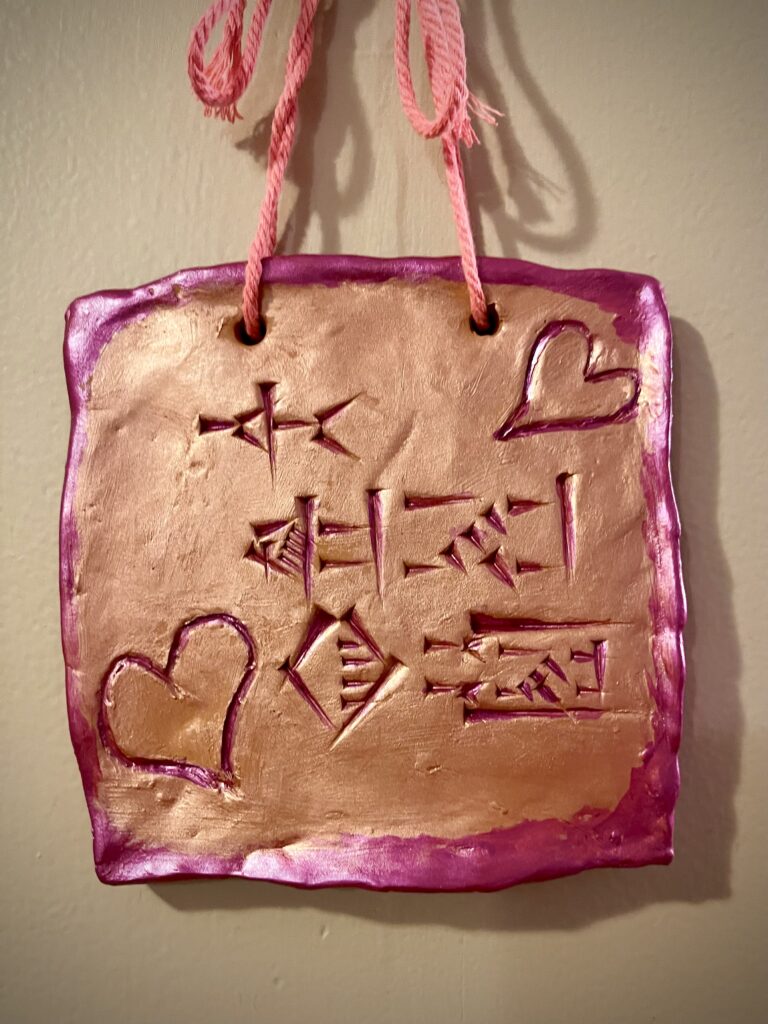
Most of my tablets I just leave plain because I like the old-timey ancient look, but this one felt like it needed something more, being a translation of a modern-day saying, so I carved a couple hearts and painted it with some metallic paint I had left over from painting a brick to make a bookend a while ago.
I’m working on utilizing print-on-demand services to offer canvas prints and t-shirts featuring this translation.
I’d also be open to taking a few commissions here and there if anyone is interested in commissioning a similar clay tablet (or one with something less silly written on it). I’m hoping to continue improving my art skills and developing them into a viable “side hustle” in case I get sick again and have to take a break from my regular day job (apparently I’m dumb for continuing to work in a daycare throughout chemo and radiation last year, but w/e. I do what I want!).
Statue of Inanna – Air Dry Clay
After I made my smaller travel figurine of Inanna, I wanted to make a larger one with more iconographic details.
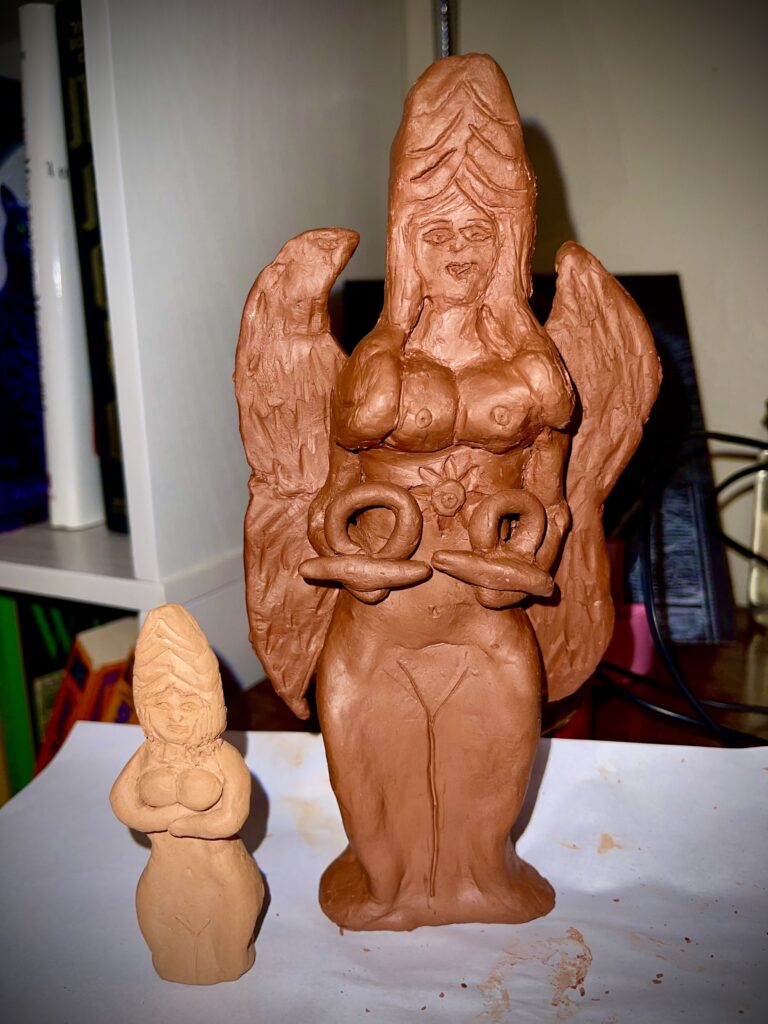
The clay was still a little wet in this picture, but this is the size difference between my original travel figurine and my new one.
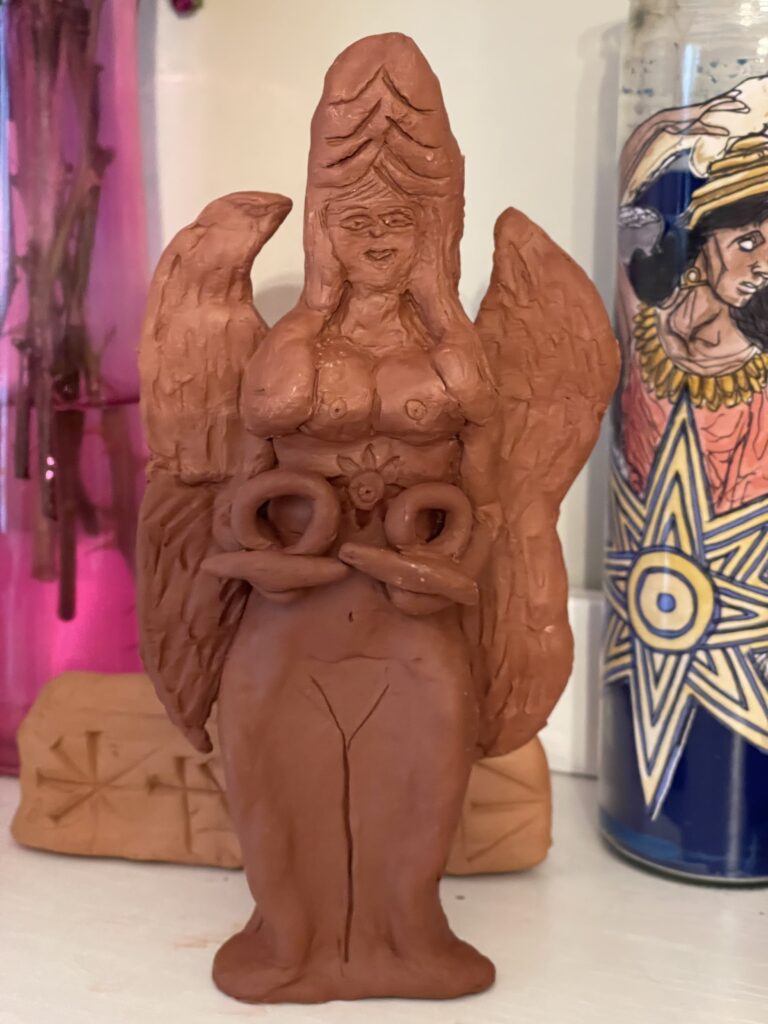
I’m not sure where she will ultimately live in my house. I kinda want her on my main altar, but I also really like the statue I have on there already that I bought from a Ukrainian artist on Etsy. For now, I have her on top of my bookcase where I keep my pagan and magick books. It’s become a kind of secondary altar/shrine to Inanna as well as Ninshubur and Dumuzi. I place offerings of freshly cut flowers there, and light candles for those three deities. The main altar is in front of a big picture window looking out into the backyard, and is where I do my actual rituals and meditations and whatnot.
T-Shirts and Merch – Nybiru Studio Relaunch (phase 1)
I had an idea to start an online shop to sell artwork, particularly sculptures and cuneiform tablets, which then led to the idea to make other kinds of more marketable wearable art too. Since I found a website that will print and ship items with my designs for me, I’m starting with that while I work on deciding where to sell physical artwork (as well as testing and choosing the best clay and other materials to use for my sculptures, and working on creating molds to reproduce small figurines, altar tools, etc that I make).
Anyway, since I already have my LLC that I haven’t done much with, I’m going to relaunch it for my artwork. Since in was originally for my game Petal Quest, and then I added my self-published books as part of the business, I don’t think it’s that much of a stretch to also add other types of art.
I’m using SpreadShop to sell shirts, stickers, mugs, and more. I have a few simpler designs ready to go, and a few more complex design ideas I’ve started drawing (I have a bad habit of jumping between different pieces as I think of new ideas, but they will all get done eventually). I have two different categories so far: “Fun and Memes” for silly things I think of, such as a shirt that says “Live Laugh Love” translated into Sumerian; and “Sumerian Polytheism” for designs to show your devotion to the deities of the Sumerian pantheon. I’m planning on making some designs for other pagan paths as well. My SpreadShop link is nybiru-studio.myspreadshop.com.

I’m waiting to promote anything on social media until the sample items I ordered arrive. I want to make sure everything is good enough quality, especially for the items bearing deities’ symbols.
For the physical artwork, I’m looking into using either Etsy or ArtPal, but I want to see what other options are out there too. Etsy is the most well-known site for selling artwork, so it’s probably the best choice for gaining exposure, but a lot of artists I know are moving away from there because of their excessive fees. I don’t know much about ArtPal, but it looks like they don’t take so much profits, and they also offer print-on-demand art prints in case I ever want to offer something like that as well.
I want to redesign my business website one of these days too. There’s a way to embed the SpreadShirt shop into my own website, so I’ll probably do that to make it more professional. I’ve started rewriting the copy for Nybiru Studio too. I’m also in the process of replacing text containing the accented ý with a normal y since it gets rendered weird sometimes, and the legal name is Nybiru Studio, LLC. This is what I put for the About page:
About Nybiru Studio
Nybiru Studio is in the processes of relaunching with a new array of Mesopotamian- and pagan-inspired artwork, altar tools, and clothing items.
The first phase of this relaunch will include wearable items and other accessories featuring my digital artwork. These items will be processed, printed, and shipped by my manufacturer.
Next, I am planning on launching a shop for handmade clay artwork, including figurines, altar tools, cuneiform tablets, and more. This is going to take more time to launch. I’m still looking into options for hosting this shop/processing payments.
I originally started this company to publish and market my game Petal Quest. Eventually I expanded it to include my books and other artistic pursuits.
About the Artist
Jennifer is an artist, writer, and Sumerian polytheist. She started working with clay to practice writing cuneiform while learning the Sumerian language and quickly discovered a love for sculpture, which she has found to be an excellent creative outlet and means of regaining fine motor strength after suffering neuropathy of the hands after chemo for breast cancer.
She began learning Sumerian as a means of connecting deeper with the Sumerian deities, particularly the goddess Inanna.
Aside from art and sculpture, Jennifer has a background in writing and graphic design for a variety of different genres and industries. She has published several books including a YA novel, a comic book, and a children’s ABC picture book.
Jennifer holds a Bachelor of Arts in English and Creative writing from Southern New Hampshire University, and an Associate of Applied Science in Computer Games and Simulation Design and an Associate of Arts from Lorain County Community College.
What Does the Name Nybiru Mean?
Nybiru Studio comes from Jennifer’s nickname “Ný” and the word “Nibiru.”
Nibiru is a term that appears in ancient cuneiform tablets to refer to a crossing point over a river, such as by boat or ferry. It can also be used to refer to certain astronomical phenomena involving crossing points of the planets, particularly Jupiter.
“Nibiru” may also refer to a fictional planet that conspiracy theorists claim is the home of aliens who visit Earth from time to time. These theories have no basis in reality and no scientific or archeological support, but they can be fun for science fiction writers to play with!
Visit Nybiru.com